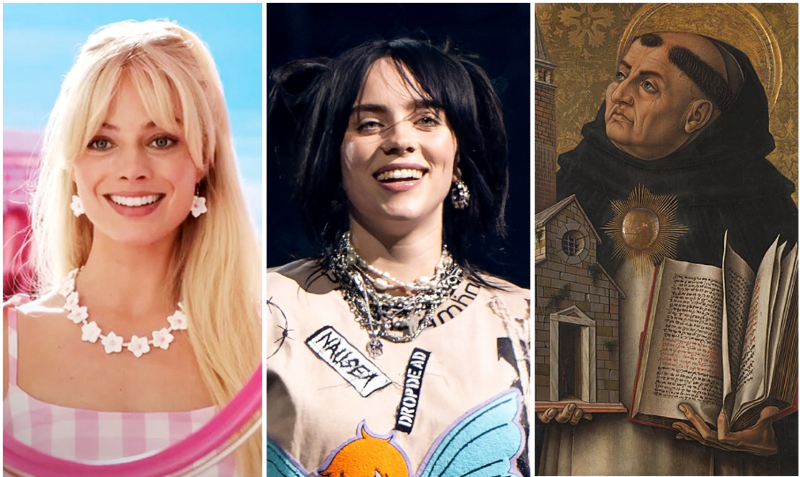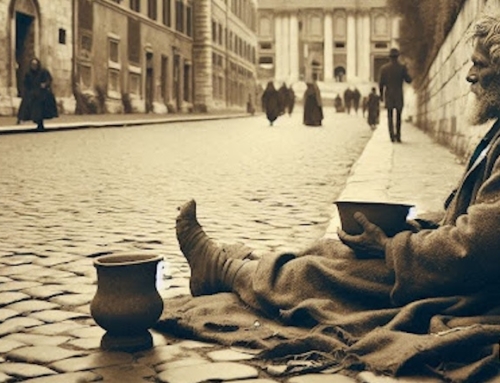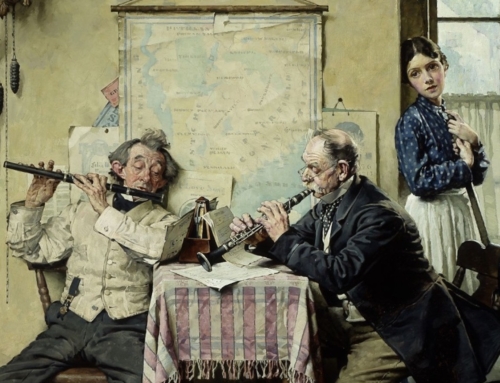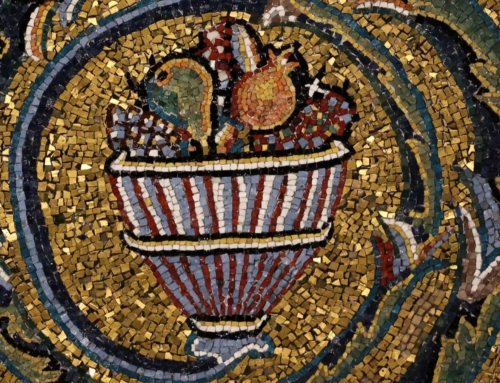Saint Thomas is never far. In our age, his wisdom can help us ponder where we least expect it. On stage, on a magazine cover, or even on the big screen. It will always be where we need it most. This post is one of a series of essays broadly named, “Thomism and Pop Culture.”
See also:
“Taylor Swift, Thomas Aquinas, and Divine Mercy”
and
“Is Tom Brady a Thomist?”
Dolls don’t die because dolls don’t live. But they are made by people, who do live and who do die and who, since the Stone Age, have dreamt their destiny through dolls. Which is why it is so ingenious that the Barbie movie should have as its central plot line the existential crisis of a doll. And not just any doll, but the most famous and culturally complicated doll in the world since its creation 65 years ago.
Whatever exactly the Barbie doll stands for—it is difficult to say—the Barbie movie stands to pose one fundamental question. Hidden underneath the film’s cupcake color scheme, acute Greta Gerwig wit, and mostly ironic wokery is a Billie Eilish song—both Grammy (Song of the Year) and Oscar winning (Best Original Composition)—whose title pronounces the movie’s sure theme: “What Was I Made For?” In its quest for an answer, Barbie grips the human imagination and calls for serious reflection, even for the insights of Saint Thomas Aquinas.
What happens when a doll who “lives her best day every day” is suddenly faced with thoughts of death, and so an end to her days? Well, she ceases to be a doll and begins to be human. And so to deal with all the “complicated human thoughts and feelings” that transpire in the “forever and irrevocably messed up” Real World—that is, our world, ailing as it is since the sin of our first parents.
The film poses this question of ultimate meaning by pivoting between two realms: the Real World and Barbie Land, home to a perfectly pink Barbie-archy, where every Barbie ever created lives, and where Ken is strictly an accessory. The plot twist lies in the dynamic between the two realms. Barbie Land, it turns out, is actually an exemplar for the Real World, an ideal world dreamed up by Ruth Handler (Barbie’s original creator) and her successors at Mattel. Barbie Land’s values are then mediated to the Real World through the Barbies that are purchased and played with by real humans. “Barbie changed everything,” narrator Helen Mirren explains in the film’s opening. “Because Barbie can be anything, women can be anything, and this has been reflected back onto the little girls of today in the Real World. Girls can grow into women who can achieve everything and anything they set their mind to. Thanks to Barbie, all problems of feminism and equal rights have been solved. At least that’s what the Barbies think. After all, they’re living in Barbie Land.”
That is, until we find out that the tether between the two realms is actually two-way. A crisis ensues when Gloria (America Ferrera)—a Mattel employee and self-described “boring mom with a boring job and a daughter who hates me”—begins to have irrepressible thoughts of death and cellulite and shame. These are, yes, common enough thoughts for the Real World, but in Barbie Land, they are unknown: Dolls don’t die, or get cellulite, or experience shame. So, when we learn that the ideas of Barbie’s human playmates actually affect Barbie Land—in a manner akin to how God’s ideas affect creation, that what God thinks, happens—we are in for a surprise. Gloria’s dark thoughts seep upward, contaminating the plastic republic. Out of nowhere, Stereotypical Barbie (Margot Robbie)—the original and most iconic of them all—suffers the effects. She begins to ponder death, fall flat-footed, and get cellulite, becoming a melange of Irrepressible Thoughts of Death Barbie and Full Body Cellulite Barbie and Crippling Shame Barbie. It is cataclysmic.
The solution? An epic rescue mission, of course. Stereotypical Barbie learns that to restore herself to original integrity, she must enter the Real World and help Gloria heal from the all-too-human thoughts that have begun to humanize Barbie. Yet the mission is not so simple. For, while Barbie retains the character of a doll in the Real World, she soon discovers herself becoming more and more human. At each major plot turn in the Real World—subtly cued by the chords of Eilish’s song—Barbie thinks and feels and loves and struggles and wonders why: why the Real World is both so meaningful and so harsh, and why Barbie Land’s ideals have not transferred to the Real World, as she had always thought.
In light of all this, some—including director and screenwriter Greta Gerwig herself—have described Barbie as an “after-Eden” tale, where Barbie Land is a kind of (feminist) paradise lost through noxious exposure to the (patriarchal) Real World. There is something to this analysis, as Barbie certainly uses the two-realmed doll trope to ask the age-old Frauenfrauge (the “woman question”): what is woman, and where is her place?
But scratch a bit more beneath the surface, and one finds that Barbie is also necessarily a movie about Ken (Ryan Gosling)—and therefore, men. (Ken’s existential crisis, too, is flagged by the Eilish chord motif.) Which makes perfect sense, since men and women are intelligible only in relation to each other: in the real Eden, male and female he created them (Gen 1:27) so that the two become one flesh (Gen 2:24), to bear fruit and multiply—an endeavor impossible for any doll.
Still, the “after-Eden” proposal requires one further element to be complete: redemption. And here, the Christian is uniquely able to perceive in the film a delightful if unintended irony: Barbie’s rescue mission entails a redemptive incarnation—except hers is an ascending incarnation from plastic, instead of a descending incarnation from the Father’s bosom.
Not surprisingly, the dynamics of redemption are inverted between Christ and Barbie. The Eternal Word—who himself knew what was in human nature (John 2:25)—became flesh not to stay with us (Luke 24:29) here below but rather to heal us, through his Cross, unto life with him in heaven. He descended so that we might ascend. Meanwhile, (Redeemer) Barbie became flesh, only to learn what was in human nature and find it better than polyvinyl—so much that she ultimately chooses to stay for good. Real life is worth living, even in a fallen world with flat feet, cellulite, and, yes, inevitable death.
The true depth of Barbie, then, is that it is a film about neither woman nor man but rather what is most common to both. For, prior to any questions of feminism or patriarchy is the question of life itself. And in Barbie’s choice for the Real World and in Ken’s own soul-searching (“I wanna know what it’s like to love, to be the real thing,” he sings at his breaking point), Gerwig underscores the primacy of this question, and our radical inability to live without addressing it. Barbie teaches us that human life (with all its struggles) is good, and that sexual difference (with all its social complexities) is real. Embracing these truths is not optional; it is a necessary part of accepting the Real World as it is and finding our way within it.
Even if the film’s script does not offer an answer to the what or Who of our ultimate end, Billie Eilish does, or at least the start of one. At the moment of Barbie’s climactic decision, as she dialogues with her human creator about what it means to be human, the (now surely recognizable) chord motif sounds again, and Billie’s song finally emerges. She sings in the person of the doll standing on the threshold of humanity and contemplating whether the leap is worth it. Barbie’s voice, Billie admits, is also her voice: “every single lyric is exactly how I feel, exactly how I feel . . . . It’s about my life.” Videos of her live performances in Britain and Chicago show she’s not alone: some 100,000 teary-eyed Millennials and Zoomers belt the refrain, “what was I made for,” and mean it. The final verse cuts to the quick:
“Think I forgot how to be happy
Somethin’ I’m not, but somethin’ I can be
Somethin’ I wait for
Somethin’ I’m made for
Somethin’ I’m made for.”
Billie’s answer, on behalf of Barbie, on behalf of herself, and by extension on behalf of every human person, is that we are made to be happy. “Man is not able not to desire to be happy,” St. Thomas Aquinas teaches as he explains that our desire for happiness is in-built, impressed upon our human nature by God himself (ST I-II, q. 5, a. 4, ad 2). It’s somethin’ I’m made for: “We desire to be happy not by free choice but by natural instinct” (ST I, q. 19, a. 10), and so the human will cannot but desire infinite goodness—God himself—for its ultimate end. Which also means that in this life, happy is somethin’ I’m not: “It is impossible that in this life, true happiness should be had” (ST I-II, q. 5, a. 3).
Barbie’s final “yes” to assume (fallen) human nature and subject herself to its limitations is profound, for she chooses to go from being a creature of man to being a creature of God—and so to have a need for redemption and a desire for infinite happiness that the Real World cannot possibly fulfill. Yet both the film and the song affirm that such fulfillment is somehow possible, that happy is somethin’ I can be. In this, Barbie and Billie grope for, even hope for, beatitude.
With our ultimate end so identified, it remains only to ask about the means.
The Incarnate Lord calls to Incarnate Barbie—now Barbara—as he calls to every human heart: I am the Way, the Truth, and the Life.
Something we’re made for.
✠
Photo (Barbie) from WallpaperCave
Photo (Billie Eilish) by RaphPH (Wikimedia Commons)
Image (St. Thomas): Carlo Crivelli, Saint Thomas Aquinas







